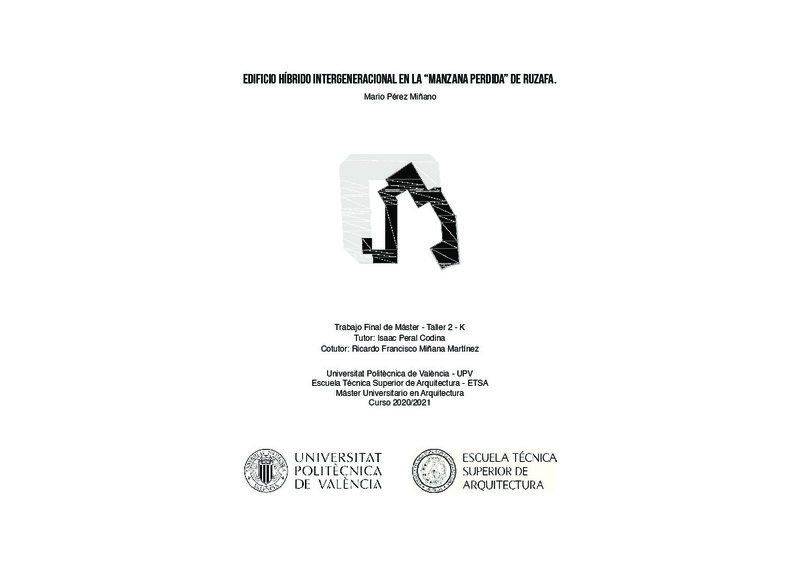|
Resumen:
|
[ES] En el Ensanche de Valencia se encuentra Ruzafa, barrio que ha experimentado un gran crecimiento en los últimos años. En décadas anteriores fue una zona maltratada y deteriorada. Con el paso del tiempo se produjo un ...[+]
[ES] En el Ensanche de Valencia se encuentra Ruzafa, barrio que ha experimentado un gran crecimiento en los últimos años. En décadas anteriores fue una zona maltratada y deteriorada. Con el paso del tiempo se produjo un relevo de la población que habitaba la zona y llegaron artistas que apostaron por el potencial del barrio que poco a poco lo fueron ocupando. En la actualidad, se ha producido una gran regeneración urbana con la llegada de mucha población joven que ha provocado un aumento de los precios y la aparición de gran cantidad de franquicias y restaurantes en los locales comerciales del barrio. Este auge de hostelería y turismo ha provocado una gentrificación que desplaza a la población y el comercio local.
El nombre de Ruzafa proviene de Russafa, que a su vez deriva del árabe, idioma en el que significa jardín. A pesar del origen del nombre, el barrio ha perdido progresivamente la presencia de espacios públicos y zonas verdes, con terrazas de bares ocupando el espacio del peatón y una gran presencia del coche.
La actuación a nivel urbano pretende revertir esta situación mediante la peatonalización de ciertas zonas, la creación de zonas verdes y equipamientos de manera que se produzca una regeneración urbana y social. En el núcleo central se encuentra la ¿manzana perdida¿, donde se ponen de manifiesto ciertos problemas al encontrarse la antigua ordenación de la ciudad con el nuevo Ensanche. En esta manzana la ciudad presenta una serie de heridas y cicatrices que se deben tratar con cuidado y sensibilidad. La propuesta edificatoria consiste en un edificio híbrido intergeneracional para jóvenes y ancianos, de manera que se favorezcan relaciones entre ambas generaciones y sinergias que favorezcan a unos y otros. La edificación se adapta a las preexistencias poniendo en valor el centro de la ¿manzana perdida¿, cediéndolo a la ciudad en forma de espacio público.
[-]
[EN] Ruzafa is located in the Ensanche de Valencia, a neighborhood that has experienced great growth in recent years. In the previous decades it was a battered and deteriorated area. Over the time the population that ...[+]
[EN] Ruzafa is located in the Ensanche de Valencia, a neighborhood that has experienced great growth in recent years. In the previous decades it was a battered and deteriorated area. Over the time the population that inhabited the area changed and this led many artists, who bet on the potential of the neighborhood, to transfer there. At present, there has been a great urban regeneration with the arrival of a large young population that has caused an increase in prices and the appearance of a large number of franchises and restaurants in the commercial premises of the neighborhood. This boom in hospitality and tourism has caused gentrification that displaces the population and local commerce.
The name Ruzafa comes from Russafa, which in turn derives from an Arabic world which means ¿garden¿. Despite the origin of the name, the neighborhood has progressively lost the presence of public spaces and green areas, replaced by bars¿ terraces that occupy the pedestrian space and a large presence of cars.
Action at the urban level aims to reverse this situation through the pedestrianization of certain places and the creation of green areas, buildings and installations to allow an urban and social regeneration. In the central nucleus there is the "manzana perdida", where certain problems are revealed when the old city planning meets the new Ensanche. In this block, the city presents a series of wounds and scars that must be treated with care and sensitivity. The building¿s proposal consists of an intergenerational hybrid building for both young and old people, to promote relationships and synergies between both generations. The building adapts to the preexistent constructions, incrementing the value of the center of the "manzana perdida", given to the city in the form of a public space.
[-]
|




![Imagen archive [IMAGE]](/themes/UPV/images/image.png)



